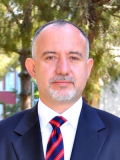Table of Contents
Definition / general | Essential features | Terminology | Epidemiology | Pathophysiology | Etiology | Clinical features | Diagnosis | Radiology description | Prognostic factors | Treatment | Differential diagnosis | Additional referencesCite this page: Özer E. Prune belly syndrome. PathologyOutlines.com website. https://www.pathologyoutlines.com/topic/syndromesprunebelly.html. Accessed April 26th, 2024.
Definition / general
- Prune belly syndrome (PBS) is a congenital disorder of the urinary system with renal, ureteral and urethral abnormalities
- The syndrome is named for the mass of wrinkled abdominal skin often present
- First described in 1839 by Frölich, but Osler gave the condition its name (Pediatr Surg Int.2012;28:219)
Essential features
- The three phenotypic features of the classical triad are:
- Urinary tract malformations such as unusually large ureters (megaureter), distended bladder (megacystitis), vesicoureteral reflux
- Partial or complete absence of the abdominal muscles
- Bilateral cryptorchidism
Terminology
- Abdominal Muscle Deficiency Syndrome, Congenital Absence of the Abdominal Muscles, Eagle-Barrett Syndrome, Obrinsky Syndrome, Fröhlich Syndrome, Triad Syndrome
Epidemiology
- Rare, genetic birth defect affecting about 1 in 40,000 births
- 97% male
- Associated with twinning - 4% of all cases are products of twin pregnancies
- Associated with trisomy 18 and 21
- Reference: Fetal Pediatr Pathol 2013;31:13
Pathophysiology
- The prevailing theory is mesodermal arrest, which explains the involvement of the genitourinary tract, testis and abdominal wall (J Urol 1994;152:2328); a noxious insult would have to occur between gestational weeks 6 and 10
- The distended bladder could result in the abnormal development of the abdominal wall musculature and prevent the descent of the testis
Etiology
- Autosomal dominant or X linked recessive inheritance has been suggested in some cases
- A homozygous mutation in the muscarinic cholinergic receptor 3 gene (CHRM3) on chromosome 1q43 was reported in one family
Clinical features
- A partial or complete lack of abdominal wall muscles
- Urinary tract abnormality such as unusually large ureters, distended bladder or vesicoureteral reflux due to obstruction; the site of obstruction may be as high as the pelviureteral junction or as low as the prostatic membranous urethra
- Cryptorchidism (undescended testicles)
- Frequent urinary tract infections
- Ventricular septal defect, tetralogy of Fallot
- Musculoskeletal abnormalities include pectus excavatum, scoliosis and congenital joint dislocations including the hip
- Others: renal dysplasia, constipation, increased pulmonary secretions, malrotation of the gut, club foot, post-ejaculatory discomfort
- Reference: Urology 2015;85:211
Diagnosis
- PBS can be diagnosed via ultrasound in utero based on an abnormally large abdominal cavity due to accumulated urine
- A rise in BUN and creatinine levels associated with decreased urine output indicates urinary obstruction in the neonate
- In young children, frequent urinary tract infections, typically uncommon, often herald PBS; diagnosis is suggested by a voiding cystourethrogram
- Diagnosis necessitates a thorough orthopaedic evaluation because of the high prevalence of associated musculoskeletal abnormalities
Radiology description
- Renal and bladder ultrasonography is recommended as early as possible to evaluate the urinary tract
- Contrast voiding cystourethrography (VCUG) should be performed
Prognostic factors
- PBS occurs with variable degrees of severity, with a mortality of 20%; with proper treatment, a longer, healthier life is possible
- In severe cases, renal dysplasia and oligohydramnios in utero result in pulmonary hypoplasia; these infants may be stillborn or die shortly after birth due to respiratory complications
- Those with less severe renal disease may survive infancy, but may have recurrent urinary tract infection or progressive renal insufficiency; some mild cases have little or no loss of renal function and therefore a better prognosis
Treatment
- Treatment depends on the severity of the symptoms (J Pediatr Urol 2015;11:276.e1)
- Vesicostomy may prevent urinary tract infections
- Consistent self-catheterization, often several times per day, may also prevent infections
- A more drastic procedure is surgical "remodeling" of the abdominal wall and urinary tract
- Boys often require orchiopexy
- If renal failure develops, the child may need dialysis or a kidney transplant
Differential diagnosis
- For antenatal hydronephrosis with hydroureter, consider:
- Posterior urethral valves: may show a keyhole sign and no evidence of cryptorchidism
- Megacystis microcolon intestinal hypoperistalsis syndrome: tends to have polyhydramnios and more females affected
- Pseudo-prune belly syndrome, which is associated with PBS uropathy, is characterized by normal abdominal wall examination findings and incomplete or absent cryptorchidism
- An abdominal wall defect commonly confused with PBS has been termed prune belly-like variant
Additional references



